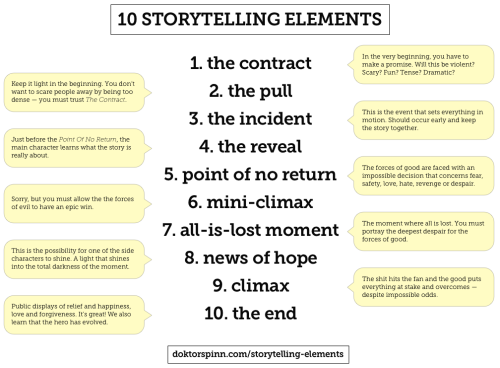amandaonwriting: The storytelling elements: 1. The Contract In…

The storytelling elements:
1. The Contract
In the very beginning, you have to make a promise. Will this be violent? Scary? Fun? Tense? Dramatic?
2. The Pull
Keep it light in the beginning. You don’t want to scare people away by being too dense — you must trust The Contract.
3. The Incident
This is the event that sets everything in motion. Should occur early and keep the story together.
4. The Reveal
Just before the Point Of No Return, the main character learns what the story is really about.
5. Point Of No Return
The forces of good are faced with an impossible decision that concerns fear, safety, love, hate, revenge or despair.
6. Mini-Climax
Sorry, but you must allow the the forces of evil to have an epic win.
7. All-Is-Lost Moment
The moment where all is lost. You must portray the deepest despair for the forces of good.
8. News Of Hope
This is the possibility for one of the side characters to shine. A light that shines into the total darkness of the moment.
9. Climax
The shit hits the fan and the good puts everything at stake and overcomes — despite impossible odds.
10. The End
Public displays of relief and happiness, love and forgiveness. It’s great! We also learn that the hero has evolved.
Article from Doktor Spinn written by Jerry Silfwer aka Doktor Spinn

